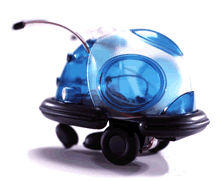|
Only a basic understanding of resistors, capacitors and transistors are needed here, and I will try and keep things as simple as possible. I have grouped the pages according to the function of Cybot i.e. The Motors And Gears, Sensors etc.
Most of the information has to be made on assumption, However, there is a lot of basic information that can be given that is the same on nearly all robots, and comes under the banner of basic components. The Sensors and Motors pages are examples of this.
Just click the links on the right to go to the relevant page. There is no specific order, although it is recommended that you start with the motors and gearing, moving onto the sensors and eventually the electronics. This will give you a 'bottom up' view of how Cybot functions, and also this is the order in which Cybot is built.
As more information comes available for Cybot, pages will be updated or added, so do check back often.

|  |
|
Some more vital Cybot information will be coming soon. |
 |
|
Motors:
Cybots motors are the core of it's movement. Without them, Cybot would be going absolutely no-where! But just how do those small metal cylindrical motors actually work?
Well, we all know that a motor converts electrical energy from a battery into movement.
All motors work the same, or on the same principles, no matter how big nor small.
Inside all electric motors, copper wires are extremely tightly wrapped around an iron core, (the rotor), and surrounding this, a permanent magnet, (the stator).
When the motor is switched on, an electric current is passed through the wires and around the core - therefor it becomes magnetised.
Just put two magnets together, and you will soon discover that they will try to turn around, so that the opposite poles line up.
Exactly the same thing happens in the motor -
the rotor turns to try and align it's own poles with those of the stator.
Every half turn, a 'communicator' reverses the direction of the current in the rotor, swapping poles, and so keeping the motor turning! |
|